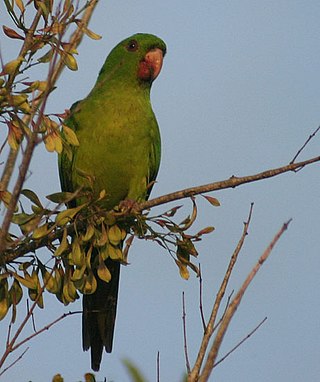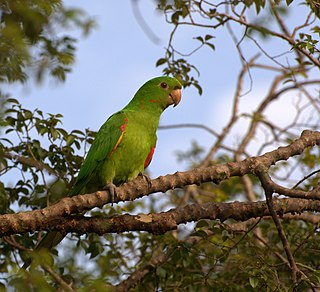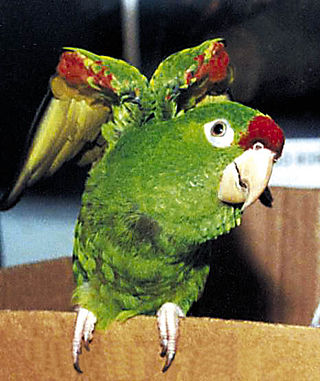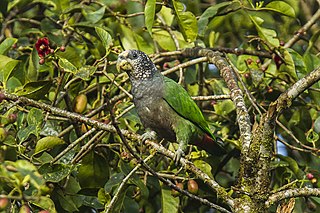
The blue-crowned parakeet, blue-crowned conure, or sharp-tailed conure is a small green Neotropical parrot with a blue head and pale beak native to large parts of South America, from eastern Colombia in the north to northern Argentina in the south. They inhabit savanna-like habitats, woodland and forest margins, but avoid dense humid forest such as the Amazon.

The Pacific parakeet, known as Pacific conure or Nicaraguan green conure in aviculture, is a species of bird in subfamily Arinae of the family Psittacidae, the African and New World parrots. It is found in southern Mexico, Guatemala, El Salvador, Honduras, and Nicaragua.

The green parakeet, green conure or Mexican green conure is a New World parrot. As defined by the International Ornithological Committee (IOC), it is endemic to Mexico.

The white-eyed parakeet, known in aviculture as white-eyed conure, is a species of bird in the subfamily Arinae of the family Psittacidae, the African and New World parrots. It is found in every mainland South American country except Chile and also on Trinidad.

The Socorro parakeet, known in aviculture as the Socorro green conure or Socorro conure, is a species of bird in subfamily Arinae of the family Psittacidae, the African and New World parrots. It is endemic to Socorro Island in the Revillagigedo Islands, Mexico.

The Hispaniolan parakeet is a Vulnerable species of bird in subfamily Arinae of the family Psittacidae, the African and New World parrots. It is endemic to the island of Hispaniola which is shared by the Dominican Republic and Haiti. In the former country it is called "perico" and in the latter "perruche".

Finsch's parakeet, also known as the crimson-fronted parakeet and in aviculture as Finsch's conure, is a species of bird in subfamily Arinae of the family Psittacidae, the African and New World parrots. It is found in Costa Rica, Nicaragua, and Panama.

The mitred parakeet, also known as the mitred conure in aviculture, is a species of bird in subfamily Arinae of the family Psittacidae, the African and New World parrots. It is native to Argentina, Bolivia, and Peru. It has been introduced to Uruguay and is established there. There are also substantial populations in the US states of California and Florida and smaller numbers in Hawaii.

The olive-throated parakeet, also known as the olive-throated conure in aviculture, is a species of bird in subfamily Arinae of the family Psittacidae, the African and New World parrots. It is found from Mexico to Costa Rica and in Jamaica; it has been introduced to the Dominican Republic on Hispaniola.

The brown-throated parakeet, also known as the St. Thomas conure or brown-throated conure in aviculture, is a species of bird in the subfamily Arinae of the family Psittacidae, the African and New World parrots. It is found in Costa Rica, Panama, the northern mainland of South America, and islands off the South American coast.

The red-throated parakeet, called red-throated conure in aviculture, is a species of bird in subfamily Arinae of the family Psittacidae, the African and New World parrots. It is found in El Salvador, Guatemala, Honduras, and Nicaragua.

The cobalt-winged parakeet is a species of bird in subfamily Arinae of the family Psittacidae, the African and New World parrots. It is found in Bolivia, Brazil, Colombia, Ecuador, Guyana, Peru, and Venezuela.

The painted parakeet, known as the painted conure in aviculture, is a species of bird in subfamily Arinae of the family Psittacidae, the African and New World parrots. It is found in Brazil, Colombia, French Guiana, Guyana, Panama, Suriname, and Venezuela.

The rose-fronted parakeet, known as the rose-fronted conure in aviculture, is a species of bird in the subfamily Arinae of the family Psittacidae, the African and New World parrots. It is found in Bolivia, Brazil, Ecuador, and Peru.

The Cuban parakeet is a Vulnerable species of bird in subfamily Arinae of the family Psittacidae, the African and New World parrots. It is endemic to the island of Cuba.

Psittacara is a genus of parakeets in the tribe Arini. Species of the genus are found in Central and South America, the Caribbean and one species reaching the southern United States. Until 2013, all the species were placed in the genus Aratinga. Many of the Psittacara species are kept in aviculture or as companion parrots, where they are commonly known as conures.

The Venezuelan parakeet or Emma's conure is a species of bird in subfamily Arinae of the family Psittacidae, the African and New World parrots. It is endemic to Venezuela.
The Sinú parakeet is a bird in subfamily Arinae of the family Psittacidae, the African and New World parrots. BirdLife International's Handbook of the Birds of the World recognizes it as a full species. The International Ornithological Committee (IOC), the South American Classification Committee of the American Ornithological Society, and the Clements taxonomy treat it as a subspecies of the painted parakeet.

The white-capped parrot or white-capped pionus is a species of bird in subfamily Arinae of the family Psittacidae, the African and New World parrots. It is found in Colombia, Ecuador, Peru, and Venezuela.

The cordilleran parakeet is a Near Threatened species of bird in subfamily Arinae of the family Psittacidae, the African and New World parrots. It is found in Ecuador and Peru.






















